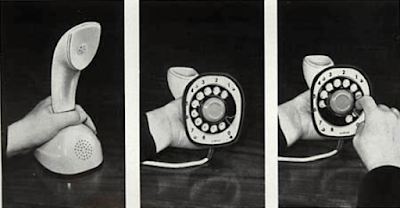 |
Image ref: Siemens ‘Crouching Dog’ single unit telephone prototype, 1930. Image credit: https://designkultur.wordpress.com/2012/01/20/designkultur-design-icon-mid-century-modern-the-ericofon/ |
Inspired, Blomberg worked with designer Ralph Lysell to produce their own version, early examples of which can be seen in the image below.
 |
| Image ref: Early prototypes for the Ericofon, 1940 Image credit: https://www.ericsson.com/en/about-us/history/products/the-telephones/snake-charming |
Two models were selected for further development but, as resources became restricted due to the war, work could not properly resume until 1949. Gösta Thames was then chosen to lead on the project because of his successful design of a loudspeaker phone that had combined all the various componentry into a single unit. This new Ericsson phone would similarly be manufactured in one piece, but it would require all of its working parts to be significantly reduced in size to fit into the shape finally chosen. It was intended to be small, light in weight, comfortable to hold and instinctive to use.
 |
| Image ref: A wooden prototype of the final form selected. Image credit: https://designkultur.wordpress.com/2012/01/20/designkultur-design-icon-mid-century-modern-the-ericofon/ |
One of the most significant problems the design team faced was the selection of materials for the case. Thames was not satisfied with either acrylic (polymethyl methacrylate) or the cellulosic plastics (cellulose acetate and nitrate) because of their proneness to scratching. He considered compression moulding the phone in Bakelite (phenol formaldehyde) but, as production was about to begin, a new thermoplastic became commercially available. ABS (acrylonitrile butadiene styrene) had been developed in 1948 but was not released until 1954. It possessed all the qualities they needed: it was rigid, hard, impact resistant, durable, resistant to chemicals, opaque, glossy and importantly, could take any colour.
 |
| Image ref: How to use the Ericofon Image credit: http://www.l2l1.com/docs/EricofonReview1956.pdf |
Production began in 1954, first to Swedish institutions such as hospitals, but within two years to the open market throughout Europe and Australia. North Electric in Ohio manufactured the phone for the American independent market. The first model released, the 600, was injection moulded in two pieces as mirrored halves that were then glued together. In 1958 the phone was redesigned to enable it to be moulded in one piece, resulting in the neck becoming shorter and more pronounced. Soon afterwards it began to be known as the ‘cobra’ phone for its resemblance to the snake.
 |
| Image ref: The Ericofon 'old' and 'new' case designs Image credit: https://www.ericofon.com/colors/shell.htm |
A third case design, the 700, was released in 1976 to mark Ericsson’s centenary. Easily distinguished by its square design, changes to the handle and the addition of a push button keypad instead of the rotary dial, it was never as popular as the earlier models.
 |
| Image ref: The Ericofon 700 model, released in 1976 Image credit: https://designkultur.wordpress.com/2012/01/20/designkultur-design-icon-mid-century-modern-the-ericofon/#jp-carousel-40328 |
In 1978, the Post Office (GPO, later to become British Telecom) released the Ericofon 600 as part of their ‘special range’ of rental telephones to be used on the UK exchange. At that time, any phones using this public network had to be owned, installed and maintained by the Post Office. The Ericofon was made available to the British market in only the orange or ivory colours whereas 18 different colours had been initially marketed within the US and 5 throughout the rest of Europe.
 |
| Image ref: The 18 different colours released in the US. Image credit: https://designkultur.wordpress.com/2012/01/20/designkultur-design-icon-mid-century-modern-the-ericofon/ |
Despite the fact that the Ericofon finally ceased production in 1984 (1974 in the US), it is still widely recognised as one of the most significant industrial designs of the twentieth century. It was completely different to the telephones widely available at the time of its release which were typically large, heavy and dark. By contrast the Ericofon was small, light, bright and colourful. The innovative design made use of new plastics materials and ergonomics to produce something really rather wonderful.
 |
| Image ref: MoDiP's Ericofon, c. 1964 - 1984. Image credit: https://www.modip.ac.uk/artefact/aibdc-005804 |
Katherine Pell, Collections Officer, MoDiP.

No comments:
Post a Comment
Note: only a member of this blog may post a comment.